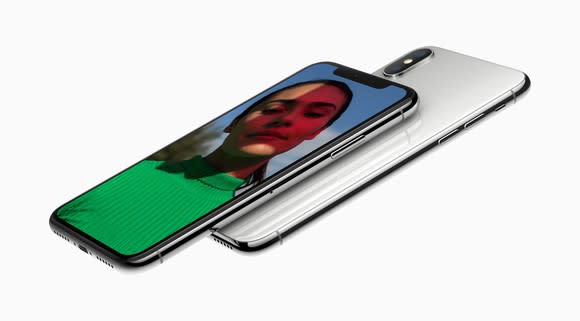Here's What to Expect From the 2018 Apple Inc. iPhone Lineup
TrendForce, a market research company that correctly predicted the details of Apple's (NASDAQ: AAPL) 2017 iPhone lineup, is out with a new report (via MacRumors) about what to expect for the next-generation iPhones.
Let's dive into the details.

Image source: Apple.
A surprising set of improvements
TrendForce claims that the flagship iPhones that Apple will introduce in 2018 will see a host of improvements. The screen-to-body ratios of the devices (i.e., the proportion of the front faces of the phones taken up by screens rather than bezels) are expected to increase, Face ID is set to get better, and Apple is also expected to boost the amount of memory in the devices.
One of the improvements -- a better implementation of its Face ID facial recognition technology -- was anticipated. While Face ID has the potential to be generally superior to fingerprint recognition, the implementation in the iPhone X isn't perfect -- it could be both faster and more accurate.

Image source: Apple.
The other two improvements are a little more surprising. You may recall that after Apple introduced the iPhone 6 and iPhone 6 Plus in the fall of 2014, it released three subsequent product generations (iPhone 6s, iPhone 7, iPhone 8) that retained the same screen-to-body ratios as the original models.
The point is that when Apple settles on a basic form factor for the iPhone, it tends to stick with it for a while.
That said, I have a way to reconcile TrendForce's report with Apple's past behavior. The company is expected to release an iPhone with a 6.1-inch liquid crystal display (LCD) to, in effect, replace this year's iPhone 8 and iPhone 8 Plus. Since that 6.1-inch LCD iPhone is expected to share the same basic all-screen design as the iPhone X, this could be part of the increased screen-to-body ratio that TrendForce is talking about.
Additionally, Apple is expected to release an iPhone next year that's, in effect, a version of this year's iPhone X with a larger 6.46-inch display (the current iPhone X has a 5.85-inch display). If we assume that such a device has a bezel around its sides that's similar in thickness to the one on this year's iPhone X and that it has the same cutout at the top for the front-facing camera, then the screen-to-body ratio will naturally go up as the cutout will make up a smaller percentage of the display's area.
And finally, per this report, Apple intends to increase the amount of memory inside the device. Now, the term "memory" is -- perhaps frustratingly -- often used interchangeably with "storage."
If TrendForce means storage when it talks about memory, then this isn't a surprise -- this year's iPhones came in 64GB and 256GB storage configurations and it's only natural to see a 512GB configuration added to next year's devices.
If TrendForce is talking about system memory -- also known as Random Access Memory or RAM -- then that's a more interesting upgrade. The iPhone 6s, 7, and 8 have all come equipped with 2GB of RAM, while the iPhone 7 Plus, 8 Plus, and X have 3GB.
More RAM is generally helpful for running large, resource-hungry apps and for running multiple apps simultaneously.
If Apple bumps up the amount of RAM that it includes in its next-generation iPhones to, say, 3GB for the 6.1-inch LCD version and 4GB+ for the higher-end models, then that could open the door to more complex apps and better multitasking capabilities on the devices (though Apple would likely see a slight bump in device cost structure as a result).
Foolish takeaway
Ultimately, it shouldn't come as too much of a shock that Apple plans to introduce better iPhones next year -- new device launches at an annual cadence is the norm in the personal computing (smartphones, tablets, laptops, and desktops) industry.
Nevertheless, it'd be quite interesting if it were to increase the amount of RAM in its devices (the company tends to be pretty stingy with the RAM that it includes in its devices) and if it were to make a significant form factor alteration with the successor to this year's iPhone X, as Apple tends to be quite conservative when it comes to form factor changes.
More From The Motley Fool
Ashraf Eassa has no position in any of the stocks mentioned. The Motley Fool owns shares of and recommends Apple. The Motley Fool has the following options: long January 2020 $150 calls on Apple and short January 2020 $155 calls on Apple. The Motley Fool has a disclosure policy.
